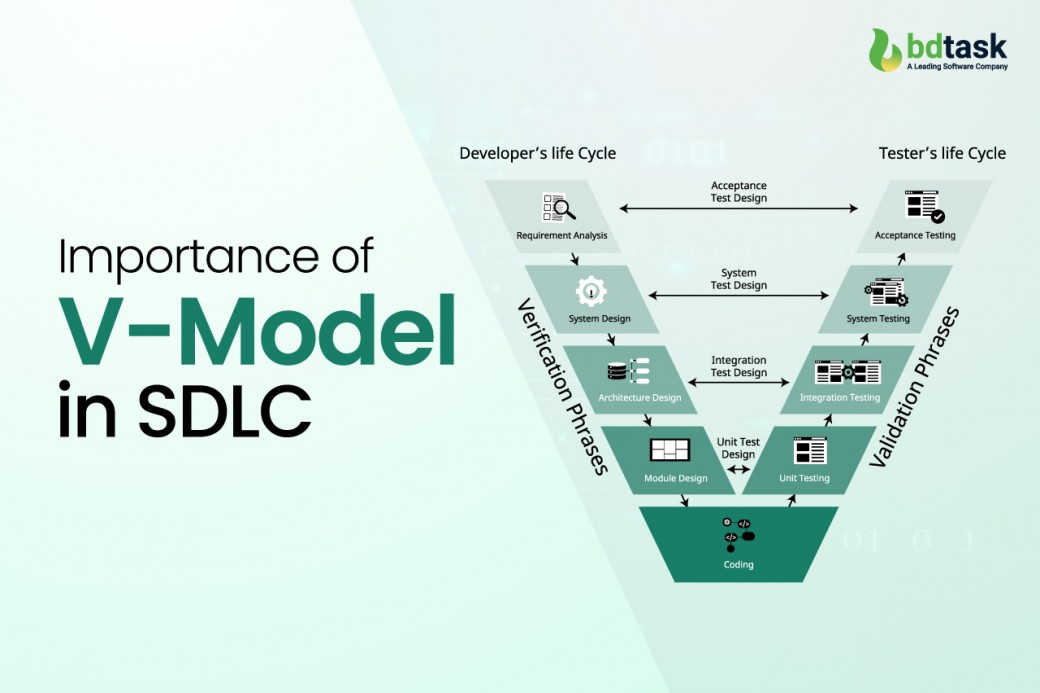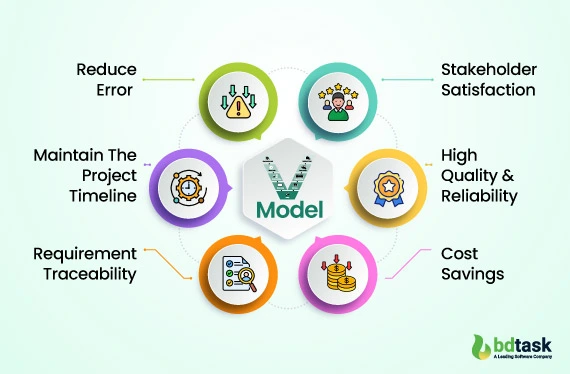Importance of V-Model in SDLC

The importance of V model in software development is quite significant. In the world of software development, a clear approach is the key to reducing errors and delivering high-quality software products. Talking of the V model, it's one of the structured and disciplined approaches in the software development life cycle.
A software model involves many software development life cycle stages. But the most important part is selecting the right one for your project. V model is well known for its quality, precision, and compliance. Choosing the V model instead of other models helps to improve the efficiency of your IT projects. It will manage risks associated with the software development lifecycle.
In this blog, we will help you learn the importance of V model and why you should use this model to develop your next big software project.
Let's discuss then!
V-Model in SDLC - Definitions
The V model is a sequential development model. It has a corresponding testing phase in every development stage. It originated from the original waterfall model. The V model in SDLC is the model that linearly flows into a more structured format that visually resembles the letter "V”. This model places a greater focus on validation and verification. Interestingly, it's also known as the Verification and Validation model. The left arm of the V represents the development phases. On the other hand, the right arm of the V model indicates development stages with their corresponding testing phases. The bottom line of the V-shape model represents the coding or implementation phase.
In the implementation of the V model project, there are several phases. Phases like
- Requirement
- The high-level design (HLD)
- The low-level design (LLD)
- The implementation
- Coding
Although there are verification phases. In these phrases, complete different types of stages like business requirement analysis, design, architectural design, module and coding. After completing each step, it goes to the next phase. On the other hand, in validation phases, it's confirmed that it meets the customer's needs and expectations. In this phase, it includes the unit testing, integration testing, system testing and finally the user acceptance testing.
Importance of V-Model in Software Development

The V shape model is simply known as the general method of the waterfall model. It offers many advantages in terms of quality assurance and software implementations. There is some importance of the V model in using this. Here are some key benefits of using the V model software development process.
Reduce Error in Project
The most significant benefits of this V model are the error identification. In the waterfall model, testing is usually an afterthought. But in the characteristics of V model, after the development sector, it goes for validation and verification before proceeding to the next stage of work. So it will help to find out each section error so easily, and if any customisation is needed, that will be fixed on that particular section. This process is obviously a plus point for developing software and also reduces the level of project errors and software bugs. This proactive problem-solving helps to reduce rework and improve the productivity level of the work.
Stakeholder Satisfaction
Another good example of using this model in software development is its ensure stakeholder satisfaction. At the beginning of any project the V-Model framework clearly outlines the vision and goal of the project.
This model tries to ensure user expectations because requirements are verified and validated consistently throughout every stage of the project development. Another importance of the V model is that it always tries to inform ongoing development activity to the stakeholders. So stakeholders are always getting updated about the process of work, and if there is any chance to change the requirement, then it's easy to tell. It's also maintaining a strong relationship between development teams and stakeholders.
Maintain The Project Timeline
Another importance of V-Model is that it always delivers the final output before the project deadline. The V model is simple to use and saves time. How exactly does it save time for any development project? Let's give you a brief that will clear out all your questions. In this framework, all the trial activities, such as designing, planning, and development, are done before the coding stage. So it saves a lot of time for software developers. V-model product development always maintains clear documentation. When you have clear documentation, it helps to
• Onboarding new team members
• Audits and regulatory compliance
• Future maintenance and upgrades
Another model, like an agile model, where documentation is the minimal priority, the V model gets maximum priority. When you have a clear objective in every stage, it will save time in the development stage. As a result of maintaining the project deadline.
High Quality & Reliability
V model product development doesn't compromise the quality of the production. It's trying to maintain a top-notch production and reliability. Proper documentation and every detail of the product make it unique and productive. Every user just wants software that is easy to use and properly functional. The V model makes sure that the application is stable
for every device and browser. An ongoing testing process at every stage helps to get a smooth & fully functional application with fewer bugs and errors. On the other hand, a continuous testing process makes sure of a bug-free code experience.
When you get high-quality software then it also improves the brand value of the software company and gives maximum ROI.
Requirement Traceability
This model helps to maintain a clear implementation and is verified in the software development lifecycle. It helps to maintain clear relationships between every single stage. Traceability is important for any SDLC project development. It's link up with the quality control of the project. On the other word, it also helps to control the risk of the project. Suppose you have a custom software development project, and its data history is uncertain. When the data history is uncertain, it leads to confusion and delays in the development stages. As a result, it can put developers at risk of out-of-compliance penalties. But using the V model, everything gets notified and stored in data management. By tracking this journey from creation to deployment, everyone involved is always notified of every detail of the work. That will help to grow confidence and efficiency in their work.
Cost Savings in Software Development
Finding the best ways to minimise the cost without compromising the quality is the top concern for any development project. So, talking about the importance of V-Model, there are other benefits of using this model. This model leads to more efficient work and saves the company valuable time and money. When all the requirements, goals, and vision are set, it's quite easy to calculate the cost of the project. The V model ensures all the requirements, vision, project cost and mission are met before going to the development stage. In that sense, there are no hidden costs in the development stages.
High-quality software and maximum ROI are the ultimate goals of any project. Reducing hidden costs and proper planning of a software improvement project can lead to maximum productivity.
When to Use The V Model in SDLC
Every model has advantages and disadvantages, and also has differences then another model. Agile, waterfall or scrum are the popular models to choose from for any software development project. Although in every way, the software development market is growing. It's about $1.3 million by 2027, with a CAGR of 22.54%.
Before picking any model, it's important to remember the requirements, vision, mission, project scope and more. Every model has its own differences then another model.
The V model is suitable for any software project of any magnitude. But some requirements need to be focused on. Let's check some of those before using this well-structured SDLC model :
- Well-defined, fixed requirements
- Safety-critical applications
- Short- to medium-sized projects
- Environments requiring extensive documentation
- Projects with little room for iterative changes
Some of the industries where the V model is the perfect choice. includes
- Automotive engineering
- Financial software
- Defence and government projects
- Aerospace systems
- Medical software device development
Necessary Steps for The Use of V Model
If you are really convinced to use this V model in your next software development project, then you need to follow the tips below before getting started.
Before creating or working on any project must discuss it with your stakeholders for the proper requirements and expectations. Tasting is the key differentiator between the V model development and the other models. Consider all the important responsibilities for each phase and make sure that your test accounts for each of them.
When you require a team, make sure they are skilled and professional. Apart from that, make sure all of the members are quite clear about their project and responsibilities. Another important thing is to make sure that they have questions, then allow them to express them. It increases the potential of their workflow and delivers quality work.
Maintaining proper communications with a team can reduce mislead or miscommunication among the members. Always communicate with other members to improve the work culture and productivity of the work.
How to Choose An SDLC Model
Always choosing the V model in your project is not the right choice. We already know the Importance of V-Model in SDLC and when to use it. Proper planning and picking the proper SDLC model can change the game of the software development industry. Here are some key factors to consider :
|
Factors to Check |
SDLC Models |
|
Project Requirements |
Clear Requirements - Waterfall or V-Model Changing Requirements - Agile or Iterative models |
|
Team Expertise |
Experienced Teams - Agile or Scrum Less Experienced Teams - Waterfall or V-Model |
|
Client Involvement |
Frequent Client Feedback - Agile, Scrum, or RAD Minimal Client Involvement - Waterfall or V-Model |
|
Project Size |
Small Projects - Waterfall or RAD Medium project - V model Large project - Agile, Spiral model or V model |
|
Maintenance and Support |
Long-term support - Agile model Minimal support - v-model of software development |
Endnote
We now know the Importance of V-Model in the software development life cycle, and it's the most structured method of software development. It's especially valuable when requirements are stable, quality is critical, and compliance is non-negotiable. Its continuous testing process ensures top-notch quality and readability, making sure a good shot for a big project and the company's ultimate growth










